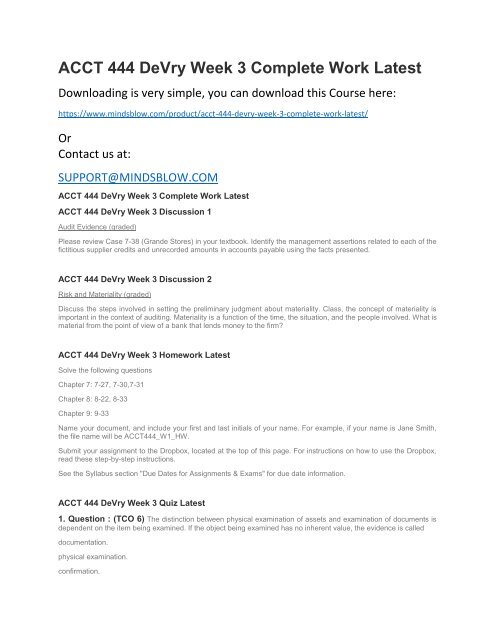ACCT 444 DeVry Week 3 Complete Work Latest
Create successful ePaper yourself
Turn your PDF publications into a flip-book with our unique Google optimized e-Paper software.
<strong>ACCT</strong> <strong>444</strong> <strong>DeVry</strong> <strong>Week</strong> 3 <strong>Complete</strong> <strong>Work</strong> <strong>Latest</strong><br />
Downloading is very simple, you can download this Course here:<br />
https://www.mindsblow.com/product/acct-<strong>444</strong>-devry-week-3-complete-work-latest/<br />
Or<br />
Contact us at:<br />
SUPPORT@MINDSBLOW.COM<br />
<strong>ACCT</strong> <strong>444</strong> <strong>DeVry</strong> <strong>Week</strong> 3 <strong>Complete</strong> <strong>Work</strong> <strong>Latest</strong><br />
<strong>ACCT</strong> <strong>444</strong> <strong>DeVry</strong> <strong>Week</strong> 3 Discussion 1<br />
Audit Evidence (graded)<br />
Please review Case 7-38 (Grande Stores) in your textbook. Identify the management assertions related to each of the<br />
fictitious supplier credits and unrecorded amounts in accounts payable using the facts presented.<br />
<strong>ACCT</strong> <strong>444</strong> <strong>DeVry</strong> <strong>Week</strong> 3 Discussion 2<br />
Risk and Materiality (graded)<br />
Discuss the steps involved in setting the preliminary judgment about materiality. Class, the concept of materiality is<br />
important in the context of auditing. Materiality is a function of the time, the situation, and the people involved. What is<br />
material from the point of view of a bank that lends money to the firm?<br />
<strong>ACCT</strong> <strong>444</strong> <strong>DeVry</strong> <strong>Week</strong> 3 Homework <strong>Latest</strong><br />
Solve the following questions<br />
Chapter 7: 7-27, 7-30,7-31<br />
Chapter 8: 8-22, 8-33<br />
Chapter 9: 9-33<br />
Name your document, and include your first and last initials of your name. For example, if your name is Jane Smith,<br />
the file name will be <strong>ACCT</strong><strong>444</strong>_W1_HW.<br />
Submit your assignment to the Dropbox, located at the top of this page. For instructions on how to use the Dropbox,<br />
read these step-by-step instructions.<br />
See the Syllabus section "Due Dates for Assignments & Exams" for due date information.<br />
<strong>ACCT</strong> <strong>444</strong> <strong>DeVry</strong> <strong>Week</strong> 3 Quiz <strong>Latest</strong><br />
1. Question : (TCO 6) The distinction between physical examination of assets and examination of documents is<br />
dependent on the item being examined. If the object being examined has no inherent value, the evidence is called<br />
documentation.<br />
physical examination.<br />
confirmation.
none of the above.<br />
Question 2. Question : (TCO 6) Analytical procedures are<br />
diagnostic tests of financial information that may not be classified as evidential matter.<br />
calculations of financial information made by a computer.<br />
substantive tests of financial information made by a study and comparison of relationships among data.<br />
statistical tests of financial information designed to identify areas requiring intensive investigation.<br />
Question 3. Question : (TCO 6) Which of the following statements regarding analytical procedures is not correct?<br />
The definition of analytical tests emphasizes a comparison of client's data to GAAP.<br />
Analytical procedures are required on all audits.<br />
Analytical procedures can be used as substantive tests.<br />
For certain accounts with small balances, analytical procedures alone may be sufficient evidence.<br />
Question 4. Question : (TCO 6) Which of the following statements about confirmation is true?<br />
Confirmations are expensive and so are often not used.<br />
Confirmations may inconvenience those asked to supply them, but they are widely used.<br />
Confirmations are sometimes not reliable and so auditors use them only as necessary.<br />
None of the above statements are true.<br />
Question 5. Question : (TCO 7) Analytical procedures used in planning an audit should focus on identifying<br />
material weaknesses of internal control.<br />
the predictability of financial data from individual transactions.<br />
the various assertions that are embodied in the financial statements.<br />
areas that may represent specific risks relevant to the audit.<br />
Question 6. Question : (TCO 7) A measure of the auditor's assessment of the likelihood that there are material<br />
misstatements in an account before considering the effectiveness of the client's internal control is<br />
acceptable audit risk.<br />
control risk.<br />
inherent risk.<br />
statistical risk.<br />
Question 7. Question : (TCO 7) Which of the following is not correct regarding the communications between<br />
successor and predecessor auditors?<br />
The burden of initiating the communication rests with the predecessor auditor.<br />
The burden of initiating the communication rests with the successor auditor.<br />
The predecessor auditor must receive their former client's permission prior to divulging information to the successor<br />
auditor.<br />
The predecessor auditor may choose to provide a limited response to a successor auditor.<br />
Question 8. Question : (TCO 8) The preliminary judgment about materiality is the _____ amount by which the<br />
auditor believes the statements could be misstated and still not affect the decisions of reasonable users.<br />
minimum
maximum<br />
mean average<br />
median average<br />
Question 9. Question : (TCO 8) When auditors allocate the preliminary judgment about materiality to account<br />
balances, the materiality allocated to any given account balance is referred to as<br />
the materiality range.<br />
the error range.<br />
tolerable materiality.<br />
tolerable misstatement.<br />
Question 10. Question : (TCO 8) Why do auditors establish a preliminary judgment about materiality?<br />
To determine the appropriate level of audit experience required for the work<br />
So that the client can know what records to make available to the auditor<br />
To plan the appropriate audit evidence to accumulate and develop an overall audit strategy<br />
None of the above

















